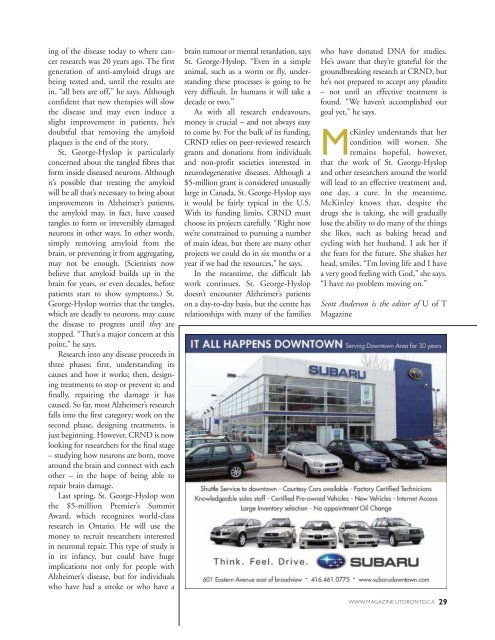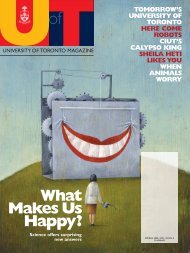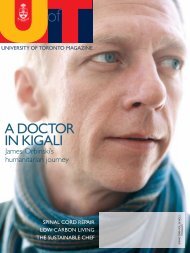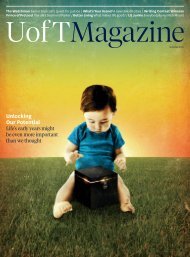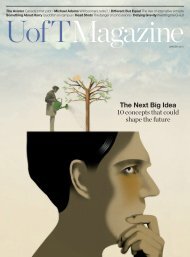THE HOUSE THAT DAVE BUILT - University of Toronto Magazine
THE HOUSE THAT DAVE BUILT - University of Toronto Magazine
THE HOUSE THAT DAVE BUILT - University of Toronto Magazine
Create successful ePaper yourself
Turn your PDF publications into a flip-book with our unique Google optimized e-Paper software.
ing <strong>of</strong> the disease today to where cancer<br />
research was 20 years ago. The first<br />
generation <strong>of</strong> anti-amyloid drugs are<br />
being tested and, until the results are<br />
in, “all bets are <strong>of</strong>f,” he says. Although<br />
confident that new therapies will slow<br />
the disease and may even induce a<br />
slight improvement in patients, he’s<br />
doubtful that removing the amyloid<br />
plaques is the end <strong>of</strong> the story.<br />
St. George-Hyslop is particularly<br />
concerned about the tangled fibres that<br />
form inside diseased neurons. Although<br />
it’s possible that treating the amyloid<br />
will be all that’s necessary to bring about<br />
improvements in Alzheimer’s patients,<br />
the amyloid may, in fact, have caused<br />
tangles to form or irreversibly damaged<br />
neurons in other ways. In other words,<br />
simply removing amyloid from the<br />
brain, or preventing it from aggregating,<br />
may not be enough. (Scientists now<br />
believe that amyloid builds up in the<br />
brain for years, or even decades, before<br />
patients start to show symptoms.) St.<br />
George-Hyslop worries that the tangles,<br />
which are deadly to neurons, may cause<br />
the disease to progress until they are<br />
stopped. “That’s a major concern at this<br />
point,” he says.<br />
Research into any disease proceeds in<br />
three phases: first, understanding its<br />
causes and how it works; then, designing<br />
treatments to stop or prevent it; and<br />
finally, repairing the damage it has<br />
caused. So far, most Alzheimer’s research<br />
falls into the first category; work on the<br />
second phase, designing treatments, is<br />
just beginning. However, CRND is now<br />
looking for researchers for the final stage<br />
– studying how neurons are born, move<br />
around the brain and connect with each<br />
other – in the hope <strong>of</strong> being able to<br />
repair brain damage.<br />
Last spring, St. George-Hyslop won<br />
the $5-million Premier’s Summit<br />
Award, which recognizes world-class<br />
research in Ontario. He will use the<br />
money to recruit researchers interested<br />
in neuronal repair. This type <strong>of</strong> study is<br />
in its infancy, but could have huge<br />
implications not only for people with<br />
Alzheimer’s disease, but for individuals<br />
who have had a stroke or who have a<br />
brain tumour or mental retardation, says<br />
St. George-Hyslop. “Even in a simple<br />
animal, such as a worm or fly, understanding<br />
these processes is going to be<br />
very difficult. In humans it will take a<br />
decade or two.”<br />
As with all research endeavours,<br />
money is crucial – and not always easy<br />
to come by. For the bulk <strong>of</strong> its funding,<br />
CRND relies on peer-reviewed research<br />
grants and donations from individuals<br />
and non-pr<strong>of</strong>it societies interested in<br />
neurodegenerative diseases. Although a<br />
$5-million grant is considered unusually<br />
large in Canada, St. George-Hyslop says<br />
it would be fairly typical in the U.S.<br />
With its funding limits, CRND must<br />
choose its projects carefully. “Right now<br />
we’re constrained to pursuing a number<br />
<strong>of</strong> main ideas, but there are many other<br />
projects we could do in six months or a<br />
year if we had the resources,” he says.<br />
In the meantime, the difficult lab<br />
work continues. St. George-Hyslop<br />
doesn’t encounter Alzheimer’s patients<br />
on a day-to-day basis, but the centre has<br />
relationships with many <strong>of</strong> the families<br />
who have donated DNA for studies.<br />
He’s aware that they’re grateful for the<br />
groundbreaking research at CRND, but<br />
he’s not prepared to accept any plaudits<br />
– not until an effective treatment is<br />
found. “We haven’t accomplished our<br />
goal yet,” he says.<br />
McKinley understands that her<br />
condition will worsen. She<br />
remains hopeful, however,<br />
that the work <strong>of</strong> St. George-Hyslop<br />
and other researchers around the world<br />
will lead to an effective treatment and,<br />
one day, a cure. In the meantime,<br />
McKinley knows that, despite the<br />
drugs she is taking, she will gradually<br />
lose the ability to do many <strong>of</strong> the things<br />
she likes, such as baking bread and<br />
cycling with her husband. I ask her if<br />
she fears for the future. She shakes her<br />
head, smiles. “I’m loving life and I have<br />
a very good feeling with God,” she says.<br />
“I have no problem moving on.”<br />
Scott Anderson is the editor <strong>of</strong> U <strong>of</strong> T<br />
<strong>Magazine</strong><br />
WWW.MAGAZINE.UTORONTO.CA 29


